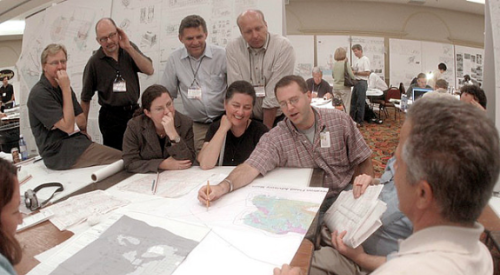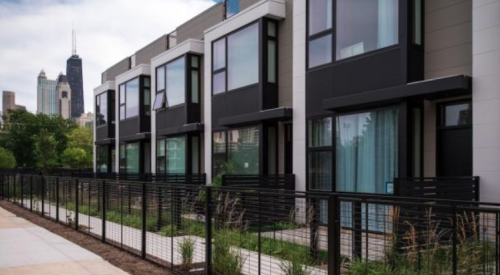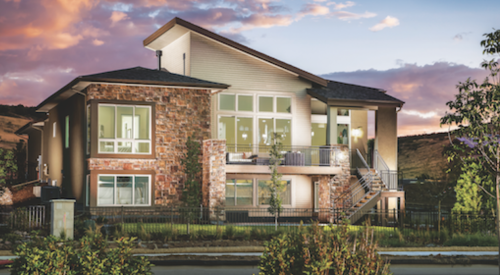| To balance historical authenticity with modern livability, front porches in Washington Town Center might use teak, mahogany and cedar, and be large enough to enjoy while still smaller than their historical counterparts. Color choices, columns, window and door trim, and other exterior finishes were chosen first for authenticity and then for low maintenance. |
Like dozens of other towns across the country, the neighborhoods of Washington Township in central New Jersey sprang up from farmland and grew haphazardly, without stopping to build an actual downtown or Main Street. Late in the game, a solution — and a real town — are being born.
Washington Town Center is a full-blown partnership between the municipality and the developer, Sharbell Development Corp. of Robbinsville, N.J. It follows a detailed, cooperative ordinance adapted from the municipality’s original, unrealized plan from the 1980s. The plan for the 150-acre site combines the existing community’s need for a center with its desire to build new homes reminiscent of those in older small towns.
The result is anything but cookie-cutter. To date, 230 homes of a projected 700 in the first plat have been sold since opening two years ago. The community has no gates or formal entry, and public areas abound: two man-made lakes, two large parks, a number of small pocket parks, walking paths, a network of human-scale pedestrian sidewalks, and the soon-to-come town center for the entire municipality. The town center will include 300,000 square feet of commercial and retail space — restaurants, small businesses, shops, a theater and even a large retail anchor.
Bob Melvin, project director for the municipality, calls the town center, which will face state Route 33, “one of the first ventures in the country to turn a state highway into a real downtown Main Street.”
The community’s design is based on traditional neighborhood design, or New Urbanist, principles, with modifications. It incorporates the basic TND concepts of varying lot sizes, varied product types, pedestrian orientation, rear-loaded garages, architecture that draws upon historical models, and a sense of neighborhood reminiscent of bygone days, but does not sacrifice livable private space in the name of public areas.
The size and shape of the lots and the location of the rear garages have been carefully planned to allow for at least 10 feet between adjacent homes and flexibility in the use of indoor and outdoor spaces. For instance, the positioning of the garages can be adjusted to enable the possibility of enlarging a room or providing additional areas within the home.
Historical Accuracy
Sharbell, although not the only builder that will build in Washington Town Center, controls two of the first three plats, offering everything from townhomes and duplexes to small and large single-family detached homes. The completed town center will even include apartments over the retail stores, mirroring what would be typical of the local housing stock and architectural vernacular of the late-19th and early-20th centuries.
One of the project’s architects, William Feinberg, CEO of Feinberg and Associates, says vastly different historical models had to be addressed to reflect the architectural vernacular of the time and place.
“The location of the community in central New Jersey puts it somewhat between Philadelphia, with its mixture of solid-brick townhouses and single-family homes with a relatively simple Colonial Williamsburg influence, and historic Princeton [N.J.], where the homes were primarily large, substantial, far more formal, and with very explicit detail and embellishment,” Feinberg says. “It was actually a matter of marrying the vernacular of both of these areas, as well as the basic farmhouse design of what was essentially, in the immediate surroundings, a primarily agricultural area.”
Washington Town Center has no clustering of homes by format or cost, and no segmented neighborhoods. Rather, every street includes homes of various formats and sizes. Tom Troy, senior vice president for Sharbell, says the idea was to capture the nostalgia and character of older homes and streetscapes while making the homes “real” and “livable.”
“We didn’t want to create ‘trophy’ housing or showplaces,” Troy says. “We wanted to bridge the gap, taking a novelty and making it more mainstream, more livable, more affordable.”
Pedestrian-oriented roads with easy access to the parks and lakes, walking paths, and the town center help make the community livable, and rear garages accessed through a system of lanes keep garage doors from marring the streetscapes. Many homes wrap around a pocket park or other green area, creating a special, natural meeting place.
| Sharbell manipulates New Urbanist design to suit the community’s needs: Curving roads slow traffic, modest back yards afford privacy while keeping density in line, and “surprise” pocket parks complement large open spaces. |
Low Maintenance
Another difference from many new home communities is that there is no homeowners association and therefore no association fees. The community doesn’t provide maintenance services or promise maintenance-free living. However, in planning the homes and the properties, every consideration has been given to making them easy to maintain. Each home has a relatively small front lawn and a back yard large enough to accommodate an outdoor entertaining or play area, yet not so large that it requires extensive care. The municipality maintains all common areas.
Wherever possible, materials and surfaces of the homes are selected for minimal maintenance. Troy, however, says the builders experienced a conflict between authenticity and low maintenance.
He cites, for instance, the historically appropriate use of mahogany, cedar and teak for porches and porch railings. “We could have used a synthetic material or something that would require less upkeep. Yet our primary emphasis was providing authenticity, which is why we went in the direction of the traditional wood surfaces, anticipating that for our kind of buyer it would be the proper decision.”
The rears and sides of homes may be clad with vinyl siding and other low-maintenance surfaces, but for the front facades, Troy was scrupulous in providing surfaces true to the period.
Code Compliance
Codes for design authenticity are part of the community ordinance — the bible upon which the whole venture is based. Melvin reviews ordinance compliance along with the town’s consulting architects, who have extensive background and experience in designing and restoring historic Princeton areas.
Although the codes set in the original ordinance are adhered to as strictly as possible, the team endeavored to make the community historically valid as well as a “living” community for mainstream buyers.
When, for instance, Sharbell’s land planners sought changes in the original land plan to provide usable backyard space for every home, the codes regarding density and the location of garages and lanes had to be examined and rethought. When the Sharbell plans called for more contemporary interior designs that could offer more open space, better flow between rooms, larger windows and more windows, the historical accuracy of the exteriors could not be sacrificed.
The original ordinance specified that all homes would have porches, and the architects designed for them. However, it was important to them that they be “real” porches that people could sit on and use. Still, the porches at Washington Town Center are slightly smaller than their historical counterparts, so the architects’ challenge was to achieve proper proportions in size and details. Even in planning the roof lines of the homes and the placement of dormers and windows, the architects had to be mindful of the proportions within which they were working and the effect that could have on the historical accuracy of their product.
Sharbell selected the architectural firms — Feinberg and Associates, based in Gibbsboro, N.J., and Devereaux and Associates of McLean, Va. — based on their experience in designing homes that draw upon historical models, their familiarity with TND/New Urbanist design and planning concepts, and their ability to bring fresh, innovative ideas to the styles. In all, the community offers 24 plans.
| Homes with varied elevations, roof lines, exterior detailing and porch treatment — all with the dual goals of authenticity and livability in mind — front a landscaped open space and are accessed as easily on foot as by car. |
Not ‘Vanilla’
From the start, Sharbell and the township were adamant that Washington Town Center would not be a “vanilla” community designed for just one kind of buyer. Rather, what was envisioned came to fruition — the diverse products, formats, price ranges and populations they hoped for are already present in the first 230 homes that buyers have occupied.
Melvin and Troy agree that this is not necessarily a community or living environment that appeals to everybody. They have found, however, that it speaks to an “unfulfilled need” for people who balk at the “homogenized” look and feel of many other communities. Sharbell markets the community as “the return of the neighborhood” and capitalizes on the opportunities the land plan offers to provide interaction and a “true sense of community.”
Buyers who have bought into the community include single people, a number of them commuters for whom proximity to a railroad station is an additional draw; young married couples, who appreciate the friendliness of the community as well as the homes’ affordability; couples who have children and like the safety of the pedestrian-oriented setting, the traditional neighborhood feeling and the opportunities for companionship with other young families; and a number of empty nesters, both pre-retirees and retirees.
The sales team reports that, for at least some of the empty nesters and retirees, the community offers an alternative to the age-restricted active-adult communities they describe as “too old for me.” Industry research consistently indicates that baby boomers are adamant about living in a community with a diverse population and diverse architectural product and designs.
It is no surprise that Washington Town Center has drawn well from the pool of baby boomers just beginning to move into a “retirement” phase of their lives. Troy says about 15% of the early buyers are boomers and that they are buying in virtually all product types and sizes.
Making It Happen
Troy says “there is no reason this kind of community can’t be done everywhere if the right ingredients are available.” He lists those ingredients as:
- a reasonable proximity to shopping, recreation, schools and other existing infrastructure. He sees the concept as particularly viable for infill, redevelopment projects, and locations that lie between developed areas and low-density surroundings.
- a governing body that’s not stuck in a rigid zoning mentality and is flexible on density.
- an interest in mixed-use development.
- a balance between public and private space.
Troy warns, however, that this kind of project is “upfront-intensive” because of the challenges for planners and engineers, and “labor-intensive” on the production side because of the extra supervision the more precise finish carpentry requires.
Still, he is expansive about the rewards to be had, on both personal and business levels. “On the personal side, it is rewarding to offer what no one else is offering — a place where people want to be and something they can’t find anywhere else. From a business point of view, I see this as a sustainable and usable alternative to single-use development and a more natural approach to how people want to live today. I have found the market very receptive.” This is supported by the fact that three other townships have approached Sharbell to develop similar communities.
Feinberg cites the personal rewards of working on the Washington Town Center venture. “It wasn’t easy, but we all learned in the process, we all grew, and we like to feel we have moved the peanut forward on both historically based design and New Urbanist community planning.”












